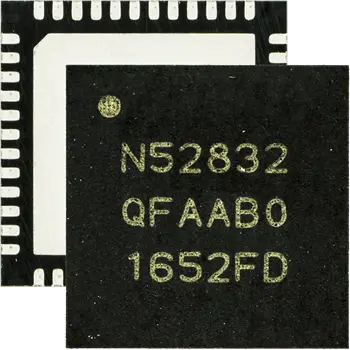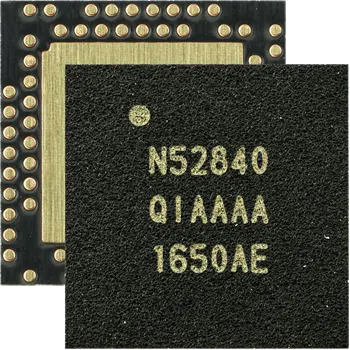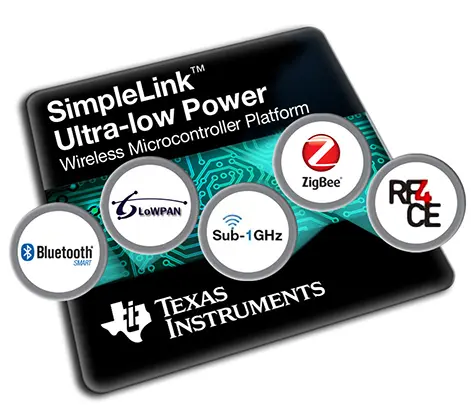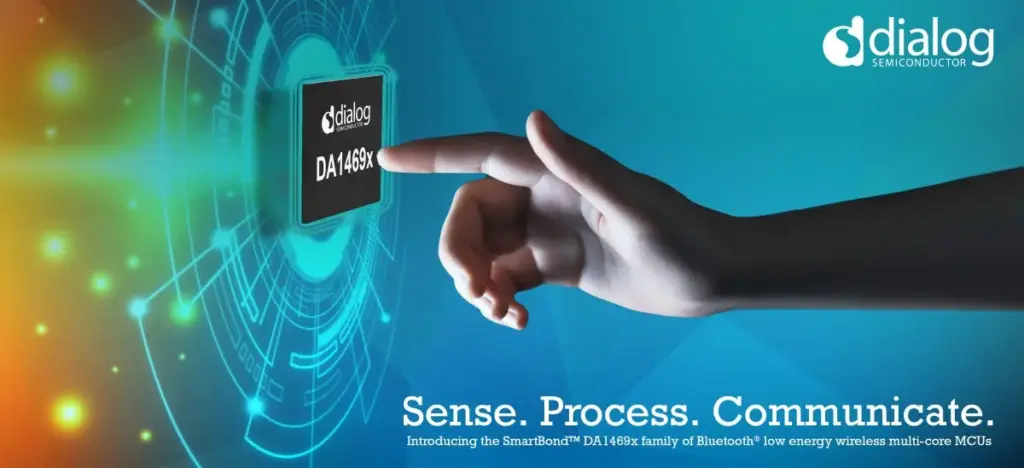Last Update: Jun 25, 2019

Overview
Many new Bluetooth Low Energy (BLE) chipsets have been released since our last review. Our previous discussion on selecting a Bluetooth chipset went over some of the second-generation devices, but today we’re going to go over the latest devices you should be designing with in 2019 and beyond.
We’re going to cover Bluetooth low Energy devices which let you connect your product to a smartphone for sending data, or create a device connection in various configurations. But, it’s important to remember these devices and BLE in general are not designed for high quality audio. If you’re looking for having a device with BLE but also with Audio capability, like speakers and headsets, then the chipset and solution there is more complex. The discussion below is our opinion and based on our experience, but it’s borne by countless designs and discussions with customers and vendors.
What can I do with Bluetooth LE?
BLE has evolved over the last few years from Bluetooth 4.0 to Bluetooth 5.0 and Bluetooth 5.1, and these changes have large ramifications on the chipsets you should be using in your products. Although Bluetooth 4.2 chipsets are still the most common today, Bluetooth 5.0 support has rapidly been making its way to new devices.
Before we cover some of the latest Bluetooth LE 5.0 features, let’s go over what you can do with BLE. At its heart, BLE lets you connect devices and send data wireless. You will typically use a BLE chipset to connect a product to a smartphone, tablet or a custom BLE device, and there are many ways to achieve this depending on the use case. Products that are enabled by BLE run the gamut and include device trackers, consumer products, smart appliances, and much more. Even Toilets have been integrated with Bluetooth LE.
BLE isn’t limited to connecting devices to smartphones. Connecting BLE devices to other BLE devices in custom products is another common use case. The advantage of using Bluetooth is that it lets you focus on your product’s functionality instead of reinventing the wheel and designing wireless protocols from the ground up. BLE is a proven technology that has been deployed by billions of devices. Bluetooth LE covers many of the use cases that use to be relegated to 915MHz/868MHz radios, but with a worldwide 2.4GHz band, frequency hopping against interference, and standardized approach for quick development.
Bluetooth Low Energy tended to work best for applications where data transfer is periodic, but with Bluetooth 4.2 and Bluetooth 5.0, fast transfers for firmware updates, log downloads and communications are better than ever, speeding the process and improving the user experience. The new 2Mbps data rate helps speed things up and enable new features.
Bluetooth 5.0

Bluetooth 5.0 was released some time ago and includes many improvements to make Bluetooth LE better, among them:
- Higher Throughput: the addition of a 2Mbps data rate enables a Bluetooth devices to transfer data twice as fast. This means that applications can be more efficient when sending large amounts of data.
- Longer Range: A new Coded PHY, which uses the 1Mbps PHY and adds redundancy for higher reliability. Although the data rate is reduced, it allows for even longer ranges (on the order of 4x).
- Higher Output Power: The specification now allows you to qualify a product with higher output power radios (up to +20dBm) which means even longer range. Over 1km links are possible. Note that this is limited in Europe and other places.
- Advertising packet extensions: up until Bluetooth 4.2, Bluetooth supported advertising on only 3 channels that would get congested with a large number of devices. Bluetooth 5 adds support for advertising extensions where many more channels are usable. This is great for reliability and allows BLE to perform even better with interference.
- Interference Improvements A new Channel Selection Algorithm (CSA #2) allows the radio to select channels better, which improves interference avoidance
All of these changes allow BLE to transfer more data more efficiently and work better, to meet the needs of product developers building BLE products. They also make BLE a much better IoT connectivity standard. One important thing to note about the longer range and higher speed features is that these are mutually exclusive: you can choose faster data rate or longer range, but not both. Extra output power is helpful in both but consumes more current.
Many of the older Bluetooth LE chipsets and Bluetooth Dual Mode (BLE + Classic) chipsets support only Bluetooth 4.2. Support for 5.0 requires changes in the chipset at the hardware level and is much more expensive for vendors to implement. Some vendors won’t be able to add support for Bluetooth 5 without significant effort.
The good news is that vendors have been working hard to add Bluetooth 5 to their devices and there are many options out there. Some of the devices we will cover will not have Bluetooth 5 support, but that doesn’t make them any less suitable for your product.
Do I need Bluetooth 5?
Since Bluetooth 5 support is still in progress, there is limited value since not every device can support it. Both devices in the BLE connection have to support Bluetooth 5 to be used, otherwise the connection will fall back to Bluetooth 4.2 or earlier (lowest common denominator). In 2019, we highly recommend having Bluetooth 5 options, even if software support will be added later by the vendors or stack. Chipsets that support Bluetooth 4.2 are slowly going to disappear and receive less and less support. But, some considerations like cost and specific features could lead you to use a Bluetooth v4.2 chipset or older. The benefits of Bluetooth 5 outweigh the effort in many cases, but you may want to analyze it if you have special use case.
Bluetooth 5.1

The Bluetooth 5.1 specification is the latest Bluetooth released in 2019 and includes changes to enable location via Angle of Arrival (AoA) and Angle of Departure (AoD) mechanisms which can be used for indoor location and positioning applications. Support for these features are enabled in the latest devices (or some specific variants).
If your application requires tracking and locating devices, then it may be critical to use Bluetooth 5.1 chipsets. Leveraging Bluetooth 5.1 requires significant design and testing to ensure reliable operation. We’ll cover it in another discussion and leave it aside in this discussion since it’s very specific.
Chipset Review
With so many options, we will go over the top vendors available, usually by market share. It’s hard to give an exact figure as far as market share since that information is usually not public, but having worked with almost all of them we have an idea of the vendors commonly used. We are also going to cover chipsets that people can usually use in products, that you can actually develop with and that we’ve used or evaluated
There are other vendors out there for BLE chipsets. Many of these focus on very low cost, other target some specific application. From our experience these devices come with a cost. Some have low RF performance. Others don’t have good software support. Some of the major point to keep in mind:
- RF Performance: Having high sensitivity and output power give you better link budget and more range.
- Peripherals: In almost all cases, the right mix of peripherals can make a huge difference in power consumption, development time, and performance.
- Power Consumption: Since most BLE devices are battery powered, power consumption is critical.
- Bluetooth Support: In almost every case it’s critical to start migrating to Bluetooth 5.0 capable devices
- Ecosystem and Support: Some companies focus on verticals, others serve the broad market and know how to make it easier for smaller engineering teams to develop systems.
- Cost: Optimizing your product’s cost can have major ramificiations to engineering and operations. Finding the right device that fits your requirements and potentially has room to grow can be essential
Nordic Semiconductor

Nordic has been a top BLE chipset vendor for many years, and at Argenox we’ve been working with Nordic’s devices for about 7 years and have created many products based on the nRF8001, nRF51822, nRF52832, nRF52840 chipsets. In recent years Nordic has introduced several devices to its lineup.
Nordic’s devices some of the most commonly used chips in consumer and industrial products, due to a combination of ease of use, great SDK support.
One great thing in Nordic’s chips is that the number of device variants are limited to 2 or 4 per device and the circuit simplicity, which makes it simple to work with. Their devices have broad software support in multiple compilers (GCC, IAR, KEIL) as well as significant software to program and test. Nordic’s devices also have significant features, owing to the long history, including the ability to have a large number of simultaneous connections. This expertise in addition to low power, ease of use and a large ecosystem has allowed Nordic to be one of the most popular devices.
Two specific features of Nordic devices are the software defined pin mapping, which allows most pins to be remappable to a specific function in software, as well as the PPI, GPIOTE and other peripherals that make low latency logic easy. In fact, we’ve used this successfully for applications such as Ultrasonic sensing
These devices are good general BLE devices and fit many applications. However, they do have some limitations that you should consider:
- Limited number of ADC channels and lower resolution than some others
- Capacitive Sensing is possible but more limited
- Bluetooth Stack runs on the same processor as the application
This last point is Nordic’s SoftDevice, which is an application independent stack that is placed in the device flash. Although this could be an issue in most cases, the SoftDevice implementation has been well done and overall the number of issues are limited. Compared to other vendors that have a seperate processor, it makes little difference.
nRF52832

Although we covered the nRF52832 chipset before, we cover it again because it is still extremely popular and should be considered one of the top chipsets to use in products. We’ve used it to build products from smart phone accessories to industrial sensors. It is likely the most popular BLE SoC in the world, if not one of the top 3.
The nRF52832 supports Bluetooth 5 High Data Rate (2Mbps) functionality, but doesn’t have the Coded PHY for long range, which isn’t a deal breaker except for specific applications. With up to 512kB of Flash and up to 32kB of RAM, it can address almost any device except the most complex mesh or multi-protocol devices. This device supports only Bluetooth 5.0 and doesn’t have any Zigbee or Thread support.
- Bluetooth 5.0 Support
- Cortex-M4F Processor
- -96dBm BLE Sensitivity
- +4dBm TX Output Power
nRF52840

The nRF52840 is the highest end nRF52 chipset that builds on top of the nRF52832. It includes all optional Bluetooth 5 features including:
- 2Mbps PHY for high speed
- Coded PHY for Long Range
In addition, what differentiates the nRF52840 from previous devices are a few other features:
- +8dBm output power (compared to only +4dBm of nRF52832). This gives you longer range without an external amplifier
- USB Device functionality
- 1MB Flash and 256kB RAM (compared to 512kB Flash / 32kB RAM of nRF52832)
- Zigbee and Thread support for multi-protocol capability
The nRF52840 is a great chip for higher end products where the additional memory, USB, higher output power and peripherals are required. It is the most expensive Nordic BLE option. The additional memory is very helpful when implementing multi-radio systems such as BLE + Zigbee or BLE + Thread devices. Bluetooth mesh and mesh solutions can also take advantage of the added memory for large networks.
nRF52810
The nRF52810 is the low end nRF52 part, but only in the sense that features were removed to allow for a cost reduction. It is similar to an nRF52832 with some peripherals and Flash/RAM removed.
- 192 KB Flash, 24 KB RAM
- USB Device functionality
- 1MB Flash and 256kB RAM (compared to 512kB Flash / 64kB RAM of nRF52832)
This part is ideal for Beacons, communication processors (connecting an existing processor via BLE) or simpler products that don’t require the peripherals, GPIOs or RF performance of the larger nRF52832 devices.
More Info: Nordic Semiconductor nRF52810
nRF52811
The nRF52811 is an SoC designed for Bluetooth 5.1 direction finding applications and is based on the nRF52810 variant. It is an enhanced version of the nRF52810.
More Info: Nordic Semiconductor nRF52811
Nordic BLE Feature Summary
| Device | 2Mbps PHY | Long Range Coded PHY | Advertising Extensions | Channel Selection Algorithm (CSA) #2 |
|---|---|---|---|---|
| nRF52810 | Yes | No | No | Yes |
| nRF52811 | Yes | Yes | Yes | Yes |
| nRF52832 | Yes | Yes | No | Yes |
| nRF52840 | Yes | Yes | Yes | Yes |
Silicon Labs

Silicon labs is another popular company that creates a wide range of BLE devices and modules as well as chipsets that include both BLE and Sub-1GHz capabilities. This allows you to bridge between custom designed wireless protocols to smartphones with a single chip.
One advantage of Silabs BLE chipsets are the dual band devices, capable of BLE and Sub-1GHz bands using time-slotting mechanism. This means you will not need to use multiple radios if your product needs to support 915MHz or similar bands while using BLE for provisioning or as a second backhaul.
Silabs also leverages BGScript functionality, where you can create a fully functioning device using a simplified scripting language instead of embedded C code. This works great for many simple devices such as BLE buttons and sensors that don’t need a lot of complexity or processing. Using it can speed up development, but may be limited when processing is needed.
Silicon labs has a multitude of devices. This is both a blessing and a curse, as the slight variations can cause significant confusion. But this can also be a boon to the product developer looking to find the right combination of features and cost.
One other differentiator for Silabs is that they create their own BLE modules, as opposed to using 3rd parties.
BlueGecko
BLE RX is 9.5mA compared to other devices at 3.3mA / 5.5mA BLE TX @ 0dBm is 8.5mA compared to other devices at 3.3mA / 5.5mA So Silabs devices are comparable but not the best in their power consumption. Part of this is the result of the high output power the devices can achieve which can impact efficiency.
More Info: Silicon Labs BlueGecko
BlueGecko Series 2
Recently Silabs announced the BlueGecko Series 2 line of devices designated EFR32BG21, which include even more features
- Cortex-M33 Processor running at 80MHz
- Up to 1MB of Flash and 96kB of RAM
- +10dBm or +20dBm Output Power
- BLE RF Performance: RX 8.8mA / TX 9.3mA
The higher performance and higher BLE radio power consumption target these devices towards higher end products where power consumption is not the top requirement, but where processing capability is.
More Info: Silicon Labs BlueGecko 2
Mighty Gecko
The Mighty Gecko line of devices is one of the highest-end set of devices offered by Silicon Labs and offers a slew of capabilities including support for BLE, Zigbee, Thread as well as Dual-Band. These devices also include large amounts of Flash, RAM and GPIOs to support the high end system in which they can be used. One downside of this is that these also represent the highest cost devices.
- Up to 1MB of Flash and 256kB of RAM
- Multi Protocol Support for 2.4GHz – BLE, Zigbee, Thread
- Dual Band Support for Sub-1GHz with 2.4GHz
More Info: Silicon Labs Mighty Gecko
Texas Instruments

TI has been in the BLE business since its inception, and the TI CC2540/CC2541 still gets used for many products. In recent years TI has release the CC2640 and variants, including the CC2642R2F which increases the amount of flash and RAM available.
TI’s CC26xx lineup include a unique feature – the sensor controller is an extremely low power CPU that can run simple operations with sensors while the main processor is asleep.
TI’s chipsets have great radio performance which allow long range. Some of the customers publicly known to use CC2640 include Tesla in its car FoBs, but there are many devices.
TI Originally had the CC2640 and CC2650 series of devices. These devices have been augmented by a new generation of devices offering more features, including devices such as the CC1350, which like Silicon Labs EFR32 enable both Sub-1GHz and 2.4GHz BLE in the same system.
TI devices run TI-RTOS and TI’s custom BLE stack. Development is usually done using one of two programming environments:
- Code Composer Studio (CCS) – Custom Eclipse based development environment which is free to use
- IAR Embedded Workbench – Commercial development environment
CCS is an IDE that was quite buggy in the past but has improved greatly with CCS 8. IAR tends to be a good option as it is mostly stable and reliable. CCS does have more visibility into TI-RTOS via plugins, giving it an edge for CC26xx development unless you have an IAR license. TI’s devices have lower flash and memory compared to other vendors, which sometimes results in issues if the device requires a lot of software functionality. We’ve had this happen a few times where even with full optimization, we had to trim functionality to get everything to run.
We recommend going with CC2640R2F at a minimum, avoiding the original CC2640 for new designs. For Bluetooth 5.1 designs or where you need more flash, CC2642R devices provide even more flash space (TI has stated Bluetooth 5.1 support is coming to CC2642R but not CC2640RF2F devices or older).
RB variants (CC2652RB) are a new kind of device that integrates the crystal internally, saving space and potentially cost. This device is at the time of this writing still in preview.
| Device | Bluetooth Support | BLE RF Performance (Sensitivity / Output Power) | Processor | Flash/RAM | Notes |
|---|---|---|---|---|---|
| CC2640R2F | Bluetooth® 5.0 | -97dBm/+20dBm | Cortex-M3 | 128KB / 28kB | BLE |
| CC2642R | Bluetooth® 5.0 | -97dBm/+5dBm | Cortex-M3 | 352KB / 80kB | BLE |
| CC1350 | Bluetooth® 5.0 | -97dBm/+9dBm | Cortex-M3 | 128KB / 28kB | Dual Band – BLE + Sub-1GHz |
| CC1352R | Bluetooth® 5.0 | -97dBm/+5dBm | Cortex-M4F | 256KB / 16kB | Dual Band – BLE + Sub-1GHz |
| CC1352P | Bluetooth® 5.0 | -97dBm/+20dBm | Cortex-M4F | 256KB / 16kB | Dual Band – BLE + Sub-1GHz with Power Amplifier |
More Info:
Cypress Semiconductor

Cypress (recently acquired by Infineon) has had presence in BLE market for a few years and released the PSOC 6 BLE lineup. PSOC and PSOC 6 devices differentiate themselves with the programmable fabric inside that allows custom hardware implementations which can reduce external logic and cost. For example, custom peripherals can be used together to avoid extra hardware.
Aside from the PSOC 6 BLE devices, Cypress also acquired Broadcom’s IoT unit under which they now sell Bluetooth Classic and Dual Mode transceivers.
PSoC 63 and PSoC 64 BLE
As with the previous generation of PSoC 4 and PRoC4, PSOC 6 BLE devices have extensive custom logic capabilities that are unique to Cypress and can be used in a wide array of application to build specific devices. If you’re using a PSoC device, then PSoC 6 BLE may be a natural extension to your system. If you require significant analog or processing capabilities, then PSoC 6 BLE may be attractive option.
These devices also include a dual core architecture, with the device containing both a Cortex-M4 processor and a Cortex-M0+ (used for BLE). One of the things that distinguishes the PSoC 6 is the very low active current power
- ARM Cortex-M4 and ARM Cortex-M0+
- Bluetooth 5.1 Support
- RF: +4 dBm output power and -95dBm RX sensitivity
- Radio current (RX/TX) 6.7mA / 5.7mA
- Up to 1MB Flash and 288kB SRAM
- USB Device and Host capability
- Cypress CapSense capability which is world class
Cypress offers the PSoC Creator development environment which allows for both source code compilation as well as an interface to configure the programmable blocks inherent to these devices.
Cypress is another company that develops custom modules for integrating their BLE devices into designs instead of relying on 3rd party module vendors.
Dialog Semiconductor

Dialog’s devices have some unique capabilities. In particular, their devices are low power, can run from different batteries and are integrated with many features in a small package. These features make them suitable for smartwatches and similar products, which is where they’ve been used. One popular product using DA14580 (an older Dialog device) is the Tile Bluetooth tracker. Some of the unique features of Dialog devices are:
- Very low power radio, down to 3.5mA (at some expense in performance
- One-Time programmable variants for low cost, along with some Flash. External flash can also be used.
- Support for Li-Polymer, Li-Ion, coin, NiMH and alkaline batteries
- Rechargeable Battery Charger
- LED Drivers
One downside for a long time has been that Dialog’s RF performance has lagged behind others. Sensitivity would be around -93dBm to -94dBm, while output power was limited to 0dBm. However, the latest generations are moving towards an improved RF that would provide a better BLE link.
DA14585 and DA14586
The DA14680 and DA14681 are an upgrade for the DA14580, the low power chipset that has been used in many devices and the one that powers the Tile Bluetooth tracker.
- ARM Cortex-M0 with 0 to 96MHz
- Bluetooth 5.0
- Support for Bluetooth Mesh
DA14680 and DA14681
The DA14680 and DA14681 are a new series of devices that include USB 1.1 support but support up to Bluetooth v4.2.
- ARM Cortex-M0 with 0 to 96MHz
- Bluetooth 4.2
- 8 Mbits of onboard Flash (DA14682)
DA14682 and DA14683
- ARM Cortex-M0 with 0 to 96MHz
- Bluetooth 5.0
- Support for Bluetooth Mesh
DA1469x
This is Dialog’s latest chipset, which is a much higher end device that is targeted towards more capable smart watches and similar higher end consumer products. However, there can be many products that can take advantage of the features and capabilities of this device.
- ARM Cortex-M33 CPU up to 96MHz, which provides extreme performance compared to many of the processors discussed above.
- Bluetooth 5.1 Support
- RF: +6 dBm output power and -97 dBm sensitivity which is at the top range of RF performance and is a huge improvement compared to Dialog’s old lineup of devices
- SB 1.1 Full Speed (12Mbps)
This device and Dialog’s other devices are typically ideal for Rechargeable Lithium Ion/Poly batteries applications (did we mention smartwatches?) where the M33 high power consumption can run.
More Info:
Qualcomm (CSR)

Qualcomm is the largest wireless connectivity company, and a few years ago they acquired CSR, a British company that pioneered much of the Bluetooth audio chipsets that dominate speakers, headsets and other devices.
CSR also developed BLE only chipsets, with mixed results. These devices, CSR102x (including the previous generation CSR101x) are very low power and usually low cost, but have some drawbacks:
- The RF performance of the family is somewhat lackluster: compared to -95dBm to -97dBm receive sensitivity of other devices from vendors such as TI to Nordic, they have -91.5dBm (CSR102x) and -93dBm (older CSR101x).
- The processing capabilities of these devices are limited due to a 16-bit processor
Although these devices are designed for broad market, the reality is that Qualcomm targets primarily high volume manufacturers. Information regarding their devices, software is often closely guarded, which requires a direct engagement with Qualcomm. CSR1xxx devices are better, but still more difficult to use compared to other vendors.
The reality is that it doesn’t seem Qualcomm has been investing much into the development of new BLE only devices. That’s not surprising given that it’s a highly competitive place and Qualcomm does much better with their Dual Mode (Classic + BLE) devices. The devices are much more targeted towards verticals such as remote controls, where there are high volume design wins instead of more general IoT products.
Despite this, these devices do have some interesting features:
- Support for CSR Mesh (now called Qualcomm Mesh). This mesh solution was adopted to a large degree by the Bluetooth SIG and CSR were pioneers in this technology.
- Integrated G.722 and G.711 audio Codecs to enable low data rate audio via Bluetooth LE – useful in applications such remotes that allow user search via voice, for example, which is one of the target use cases
| Device | Bluetooth Support | Processor | Memory | Notes |
|---|---|---|---|---|
| CSR1020 | Bluetooth® 5.0 | 16-bit 16MHz RISC | 256KB / 16kB | One-Time Programmable |
| CSR1021 | Bluetooth® 5.0 | 16-bit 16MHz RISC | 256KB / 16kB | One-Time Programmable |
| CSR1024 | Bluetooth® 5.0 | 16-bit 16MHz RISC | 256KB / 16kB | Flash |
| CSR1025 | Bluetooth® 5.0 | 16-bit 16MHz RISC | 256KB / 16kB | Flash |
NXP

Through its acquisition of Freescale a few years ago, NXP added the Kinetis BLE line of BLE SoCs in addition to its own line of devices.
KW36 and KW35
These devices represent the latest offering from NXP, an upgrade from their KW41 series which came from Freescale. One of the unique features of the KW36 is the addition of a CAN bus, since these devices are targeted mostly at automotive applications. the KWxx series are also automotive qualified.
- Cortex-M0+
- Bluetooth 5.0 Support
- RF: +3.5 dBm output power and -95 dBm
- Radio 6.1mA / 6.8mA
QN908x
These devices represent the latest offering from NXP originally from the NXP side of the acquisition. The RF performance is decent but they distinguish themselves with very low power consumption.
- ARM Cortex-M4F C
- Bluetooth 5.0
- RF: +2 dBm output power and -95 dBm
- 3.4mA RX and TX current which is very low
- Flash/RAM of 512 KB / 128 KB
ST Micro

ST is a leader in Cortex-M processors and their line of processors is used in countless products. They’ve also expanded into BLE with the BlueNRG line of devices whose performance was not as competitive as other devices. However, ST has recently launched the STM32WB55xx line of advanced BLE devices that are based on the STM32L4 and that rival the best of BLE chipsets.
STM32WB55xx
STM32WB55xx blends many of the features ST is famous in its line of microcontrollers to create an industrial high-end device with a slew of features:
- Integrated Touch Sensing and LCD controller
- Variants of Flash and RAM density for optimizing cost/feature
- Integrated capacitive sensing
- 13 or 19 ADC channels for analog intensive applications
- Power optimization with nA level power consumption
The STM32WB55xx devices do not support LE Long Range, which could be a requirement for some industrial or commercial applications.
BLE Device Comparison
| Device | Protocols | BLE RF Performance | Processor | Flash/RAM | Current Consumption BLE @ 0dBm |
|---|---|---|---|---|---|
| Nordic nRF52810 | Bluetooth® 5.0 | -96dBm / +4dBm | Cortex-M4 | 192KB / 24kB | 4.6mA / 4.6mA |
| Nordic nRF52811 | Bluetooth® 5.1, 802.15.4, Thread, Zigbee | -96dBm / +4dBm | Cortex-M4 | 192KB / 24kB | 4.6mA / 4.6mA |
| Nordic nRF52832 | Bluetooth® 5.0 | -96dBm / +4dBm | Cortex-M4 | 192KB / 24kB | 4.6mA / 4.6mA |
| Nordic nRF52840 | Bluetooth® 5.0, 802.15.4, Thread, Zigbee | -95dBm / +8dBm | Cortex-M4 | 1MB / 64kB | 4.6mA / 4.6mA |
| TI CC2640R2F | Bluetooth® 5.0 | -97dBm/+20dBm | Cortex-M3 | 128KB / 28kB | 5.1mA / 6.1mA |
| TI CC2642R | Bluetooth® 5.0 | -97dBm/+5dBm | Cortex-M3 | 352KB / 80kB | 5.1mA / 6.1mA |
| TI CC1350 | Bluetooth® 5.0 | -97dBm/+9dBm | Cortex-M3 | 128KB / 28kB | 5.1mA / 6.1mA |
| TI CC1352R | Bluetooth® 5.0 | -97dBm/+5dBm | Cortex-M4F | 256KB / 16kB | 5.1mA / 6.1mA |
| TI CC1352P | Bluetooth® 5.0 | -97dBm/+20dBm | Cortex-M4F | 256KB / 16kB | 5.1mA / 6.1mA |
| Qualcomm CSR102x | Bluetooth® 5.0 | -92dBm / +4dBm | 16MHz 16-bit RISC | 64kB / 16kB | < 5mA |
| Dialog DA1469x | Bluetooth® 5.1 | -92dBm / +4dBm | Cortex-M33 | 32 Mbit (ext.) / 512kB | < 3.5mA |
| ST STM32WB55 | Bluetooth® 5.0, Zigbee, Thread | -96dBm / +6dBm | Cortex-M4F | 1MB / 256kB | 4.5mA/5.2mA |
| Silabs EFR32BG21 | Bluetooth® 5.0, Zigbee, Thread | -97dBm / +20dBm | Cortex-M33 | 1MB / 96kB | 8.8mA/9.3mA |
| NXP KW36 | Bluetooth® 5.0 | -95dBm / +3.5dBm | Cortex-M0+ | 512kB / 64kB | 6.1mA / 6.8mA |
| NXP QN908x | Bluetooth® 5.0 | -95dBm / +2dBm | Cortex-M4F | 512kB / 64kB | 3.4mA / 3.4mA |
Every product is unique, so finding the right device could be easy or difficult depending on the specific product requirements.
If you’re comparing devices, make sure to look at the fine print regarding RAM and Flash/ROM. In some cases, RAM is being used for the BLE stack or for other purposes and you will have less space than you thought for your application. In TI devices, some RAM is actually shared.
We covered primarily the current consumption of the radio, using it as a proxy for overall power measurement. The reality as you can imagine is much more complicated. Depending on your application, active current or sleep current will dominate. Also, the CPU activity will matter, and some of the CPUs are more sophisticated than others, capable of processing data faster. Therefore, this could require significant analysis of the actual application to optimize. In reality, optimizing solely for power consumption can’t be done except where the BLE application is highly focused. Other factors matter: cost, software support, etc.
Conclusion
We’ve covered some of the most popular BLE and Bluetooth devices, their specifications and some of the key aspects to keep in mind when making a decision.
As always, there are many details and concerns that come into play when creating a BLE product. We’re committed to help you get it done right, so feel free to get in touch with us to discuss.
Photos courtesy of Nordic Semiconductor, Texas Instruments, Cypress Semiconductor, Qualcomm, Dialog Semiconductor and Silicon Labs.








